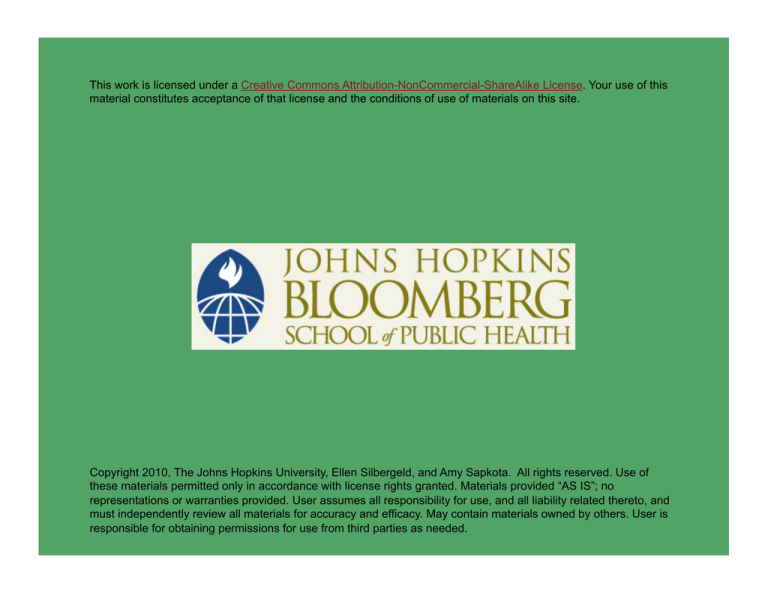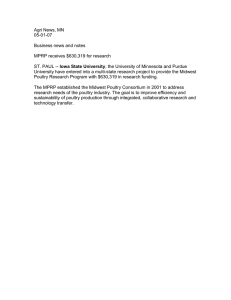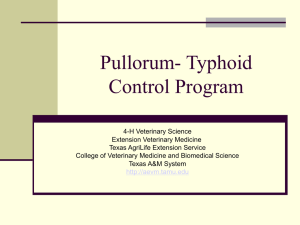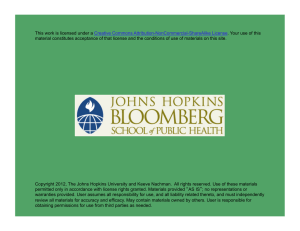
This work is licensed under a Creative Commons Attribution-NonCommercial-ShareAlike License. Your use of this
material constitutes acceptance of that license and the conditions of use of materials on this site.
Copyright 2010, The Johns Hopkins University, Ellen Silbergeld, and Amy Sapkota. All rights reserved. Use of
these materials permitted only in accordance with license rights granted. Materials provided “AS IS”; no
representations or warranties provided. User assumes all responsibility for use, and all liability related thereto, and
must independently review all materials for accuracy and efficacy. May contain materials owned by others. User is
responsible for obtaining permissions for use from third parties as needed.
IAP: Occupational and Community Impacts; Real
Communities, Real People
Ellen Silbergeld, PhD
Amy (Chapin) Sapkota, PhD, MPH
Johns Hopkins University
Module 5
IFAP: Economics, Occupational
Health, and Rural Communities
Community Health Effects of Swine CAFOs
(Real Communities, Real People)
Amy (Chapin) Sapkota, PhD, MPH
Johns Hopkins University
Amy R. (Chapin) Sapkota
Environmental Epidemiologist
and Acting Director, Maryland
Department of Health and
Mental Hygiene’s Office of
Environmental Health
Earned her PhD in 2005 from
the Bloomberg School
Research Director, Center for a
Livable Future
Assistant Professor, the
University of Maryland College
Park School of Public Health
Research interests include
pathways of antibiotic
resistance and resistance genes
from food animal production
5
Section A
Real Communities, Real People: Community Health
Effects Associated with Swine CAFOs
Research at JHSPH
Research at JHSPH on AMR and food-animal production
- Epidemiology
Exposure, health outcomes
- Product monitoring
Poultry products testing
- Environmental studies
Pathways and routes of exposure
- Air, water, dusts, soils
- Biotic transfers—wildlife studies
- Molecular microbiology
Tracking pathogen movement
Tracking gene transfer
Microbial population genetics/diversity
- Policy analysis
Economic analyses
Scientific basis for risk assessment
7
Maryland’s Eastern Shore: The Pocomoke River
JHSPH OpenCourseWare has removed this
image because license for its use could not
be secured
8
Many Nonfood Routes of Exposure and Transfer
ENVIRONMENT
rivers and streams
Irrigation
Drinking water
Sea
Manure spreading
Farm effluents
Offal
FARMS
Animal
feeds
Sheep
Pigs
Cattle
Crops
Poultry
Swimming
Sewage
Slaughter
Harvesting
Processing
Handling
Preparation
Consumption
HUMANS
Urban
Rural
Institutions
Fish
Contact
Source: Adapted from Dr. Ruth Etzel. USDA.
High-risk populations
• Children
• Elderly
• Immunocompromised
9
Case Study: Delmarva Poultry Industry
600–800 million broiler chickens produced annually
6,000 broiler chicken houses
2,500 chicken growers
15,000 poultry employees
Total annual gross income of Delmarva broiler industry: exceeds 1.3
billion dollars
10
The Other Product of CAFOs
Image Source: USDA
11
The Delmarva Peninsula’s “Other Product”
>1,000,000 tons of “manure”
produced by ~800 million chickens per year
Integrators own the birds
Growers own the waste
Management—largely land applied
Image Source: USDA
12
Why Are We Concerned?
More biosolids applied than land can handle
Contributes to surface and ground-water contamination
Increased nutrient runoff into surface waters
Detectable presence of drugs and resistance determinants in
ground-water
13
Pocomoke River
JHSPH OpenCourseWare has removed this
image because license for its use could not
be secured
14
CAFOs Are an Environmental Justice Issue
Location
- CAFOs and processing plants are located in areas with low
socioeconomic status (SES) and high minority populations
Organization
- The industry is modeled on share cropping
15
Organization
Sharecropping model
- Vertically integrated, from feed to table
- A few large producers (e.g., Tyson, Perdue, Smithfield, IBC)
control all aspects of production
- Growers contract with producers
- Producers contract with chicken workers
- Compensation based on piece work
16
Location
Odds ratio of hog CAFOs by race/income—Mississippi counties
Percent Black
0–25% poverty
25–100% poverty
0–29%
1 (ref)
2.68
30–100%
2.84
1.35
Source: Wilson et al. (2002). EHP, 110, Supplement 2, 195–201.
17
Location (Continued)
Odds ratio of hog CAFOs by race/income—North Carolina
Nonwhite %
Poverty %
0–2%
2–10%
10–100%
0–5%
1 (ref)
1.4
1.1
5–12%
1.8
3.6
7.0
12–100%
1.7
3.1
9.6
Source: Wing et al. (2000). EHP. 108, 225–231.
18
Who Is at Risk for Exposure?
Workers and growers who work in broiler houses
Workers who handle live chickens at processing plants
Household members of these persons
Community residents
19
The Poultry Environment Health Study
Hypotheses
- Persons with direct exposure to the poultry environment are at
increased risk of exposure to ABR
- Exposed persons are at increased risk of bacteria-associated
outcomes
- There is a gradient of exposure, and health risk, among
workers, their families, and the community
20
The Poultry Environment Health Study
Subjects
- Poultry house workers
- “Live hangers”
- Growers
- Household members
- Community residents
21
Working in the Poultry Industry
JHSPH OpenCourseWare
has removed this image
because license for its
use could not be secured.
22
Living Near the Poultry Industry
Hatcheries
Feed mills
Slaughterhouses
Rendering plants
Deboning plants
JHSPH OpenCourseWare has removed this
image because license for its use could not
be secured
23
Shallow Aquifers in Delmarva
24
The Poultry Environment Health Study
Exposure risks
- Pathogens
- Antibiotic resistance
- Antibiotics
- Arsenic
Pathways
- Air, water, dusts, wildlife, caught fish, food plants
25
Airborne Risks of Exposure: Maryland Hog Farms
Bacteria—Enterococcus
Antibiotic resistance pattern
E. dispar (n = 4)
Ery, Clin, Tet
E. durans (n = 2)
Ery, Clin
Ery, Clin, Virg
E. faecalis (n = 6)
Tet
Ery, Clin, Tet
Ery, Clin, Tet, Virg
E. faecium (n = 1)
Ery, Clin, Tet, Virg
E. hirae (n = 14)
Ery, Clin
Ery, Clin, Tet
Ery, Clin, Tet, Virg
Other Enterococcus (n = 11)
Ery, Clin, Tet
Source: Chapin et al. (February 2005). Environ Health Perspect, 113, 2, 137–142.
26
The Poultry Environment Health Study
Outcomes
- Bacterial carriage
- Reported diarrheal disease
- Respiratory function tests
- Neurological symptoms
Methods
- Isolation of bacteria from stool; measurement of antibodies in
sera
- Questionnaires
- Respiratory function testing
27
Arsenic Sources: U.S.
Map source: http://nationalatlas.gov/articles/water/a_arsenic.html.
28
Arsenic: The Forgotten Antibiotic
Extensive use of arsenicals in broiler feeds
Documented contamination of waste and amended land
Percolation into groundwater
Arsenic is a human carcinogen associated with skin, liver, and
cardiovascular disease
29
Arsenic and Poultry
Roxarsone, arsanilic acid used in poultry as coccidiostats and growth
promoters—45 g/ton feed
GP—continuous lifelong exposure in feeds
Arsenicals excreted (>70%)
100–200 mg/bird (900 million/year)
50,000–90,000 mt/year arsenic
Arsenicals —> inorganic arsenic
Leach into groundwater
30
A Suggestive Trace
Cancer Mortality Rates for Maryland Counties, 1995–1997
Counties with mortality
rate significantly higher
than U.S. rate
Source: CDC.
31
JHSPH–University of Arizona Collaboration
To test the geographic correlations between drinking water and
- Land use/agriculture/waste disposal
- Hydrology
- Cancer incidence
- Atherosclerosis …
32
Results to Date
Arsenic levels in some Delmarva tap water exceeds the EPA
standard!
U.S. Geological Survey database does not accurately predict arsenic
exposures via drinking water
33
Acknowledgements
Students
- Jon Furuno, Amy (Chapin) Sapkota, Lance Price, Jay Graham,
Amira Roess, Meiche Nweke, Keeve Nachman, Carter Erwin,
Patrick Butler, Redwan Huq
Colleagues
- Carol Resnick, Rocio Vailes, Pat Charache, Kellogg Schwab, Rolf
Halden, Pat Breysse, Bill Spannhake, Kris Macri, Tim Buckley,
Pat Charache, Steve Harvey, Vasken Aposhian, Tracy Hancock,
Henrik Wegener
- Carole Morison, Patrick Harmon, Jim Lewis, Pilar Perez, et alia
Funding
- CLF, Grace, HHMI, NIOSH, Winslow and Baker Foundations
34






